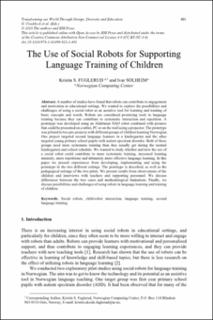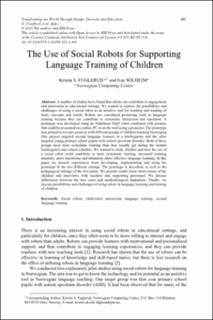| dc.contributor.author | Fuglerud, Kristin Skeide | |
| dc.contributor.author | Solheim, Ivar | |
| dc.date.accessioned | 2022-03-17T12:03:47Z | |
| dc.date.available | 2022-03-17T12:03:47Z | |
| dc.date.created | 2019-01-29T14:13:35Z | |
| dc.date.issued | 2018 | |
| dc.identifier.citation | Studies in Health Technology and Informatics. 2018, 256 401-408. | en_US |
| dc.identifier.issn | 0926-9630 | |
| dc.identifier.uri | https://hdl.handle.net/11250/2985822 | |
| dc.description.abstract | A number of studies have found that robots can contribute to engagement and motivation in educational settings. We wanted to explore the possibilities and challenges of using a social robot as an assistive tool for learning and training of basic concepts and words. Robots are considered promising tools in language training because they can contribute to systematic interaction and repetition. A prototype was developed using an Aldebaran NAO robot combined with pictures that could be presented on a tablet, PC or on the wall using a projector. The prototype was piloted in two pre-projects with different groups of children learning Norwegian. One project targeted second language learners in a kindergarten and the other targeted young primary school pupils with autism spectrum disorder. Both of these groups need more systematic training than they usually get during the normal kindergarten and school schedule. We wanted to study whether and how the use of a social robot could contribute to more systematic training, increased learning intensity, more repetitions and ultimately more effective language learning. In this paper we present experiences from developing, implementing and using the prototype in the two different settings. The prototype is described, as well as the pedagogical settings of the two pilots. We present results from observations of the children and interviews with teachers and supporting personnel. We discuss differences between the two cases and methodological limitations. Finally, we discuss possibilities and challenges of using robots in language learning and training of children. | |
| dc.language.iso | eng | en_US |
| dc.relation.uri | http://ebooks.iospress.nl/publication/50588 | |
| dc.rights | Navngivelse-Ikkekommersiell-DelPåSammeVilkår 4.0 Internasjonal | * |
| dc.rights.uri | http://creativecommons.org/licenses/by-nc-sa/4.0/deed.no | * |
| dc.subject | Realfag og teknologi | |
| dc.subject | Botanikk | |
| dc.title | The use of social robots for supporting language training of children | en_US |
| dc.type | Peer reviewed | en_US |
| dc.type | Journal article | en_US |
| dc.description.version | publishedVersion | |
| dc.description.version | publishedVersion | |
| cristin.ispublished | true | |
| cristin.fulltext | original | |
| cristin.fulltext | original | |
| cristin.qualitycode | 1 | |
| dc.identifier.doi | 10.3233/978-1-61499-923-2-401 | |
| dc.identifier.cristin | 1667635 | |
| dc.source.journal | Studies in Health Technology and Informatics | en_US |
| dc.source.volume | 256 | en_US |
| dc.source.pagenumber | 401-408 | en_US |


